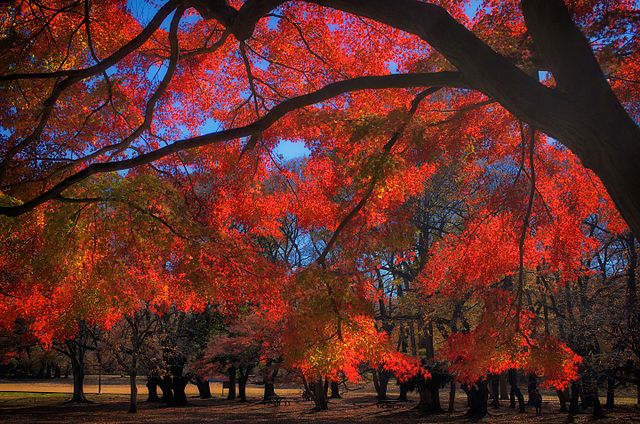Oct 25, 2022
The History of Japan’s Majestic Fall Colors
Japan’s most popular season for tourists is undoubtedly spring. When the cherry blossoms bloom, people from inside Japan and worldwide gather in popular, beautiful spots to bask in the traditional scenes of pinks, reds, and whites that form many of our preconceptions of Japan’s natural state.
However, what is less known internationally is the second season of natural beauty in Japan: autumn. This is when this country’s mountainous forests burst aflame (figuratively speaking) into stunning reds, orange, and golds; easily rivaling spring for its dramatic majesty.
What are Koyo and Momiji?

While not particularly famed overseas, autumn is a significant time of the year for the Japanese. Thousands – if not millions – of people travel great distances to beautiful spots to observe, photograph, and bask in the glory of the changing colors.
This pastime can take on two names: ‘koyo’ and ‘momiji.’ While both words use the same kanji characters (紅葉) that literally mean ‘red’ and ‘leaves,’ separated their different pronunciations take on alternative significance, with the former taken to mean the general act of viewing autumn leaves, while the latter (also known as ‘momijigari’) refers specifically to the enjoyment of the more dramatic maple leaves.
Starting in mid-September in Hokkaido to the north, the ‘koyo front’ sweeps southwards across the country, reaching the southern areas of Japan in late November.
The History of Fall Color Viewing

Like many aspects of culture that we think of as typically Japanese – cherry blossom viewing, flower arrangement, and haiku poetry – koyo has its origins in the pastimes of the noblemen and women who made up the imperial court of Kyoto in the early samurai periods. In spring, these aristocrats, who would contemplate the cherry blossom trees in their own gardens, found that they were unable to do the same with the striking autumn colors.
In the Shinto belief, where spirits inhabit all aspects of nature, immense significance is held in changing the autumn leaves. The experience of these spirits transforming before their very eyes inspired great reverence amongst the people.
As such, these courtiers undertook great excursions to the mountainous regions where they could spend time contemplating and reflecting upon the world and composing music, poetry, art, and literature with the beauty that surrounded them as inspiration. Notable works of art that stem from this time include the eleventh-century literary classic ‘The Tale of Genji’ by Murasaki Shikibu and the Kokin Wakashu poetry of the Heian era, which relied on momiji as a ‘kigo’ (seasonal word).
In the mid-18th century, the custom spread to commoners, and the pastime became widely popular throughout the country, inspiring yet more artwork such as a famous haiku by the priest and poet Ryōkan (1758-1831):
うらを見せ おもてを見せて 散るもみぢ
Ura o mise / omote o misete / chiru momiji
Showing its back
showing its front—
falling maple leaf
The seasonal viewing of autumn leaves also inspired the ‘noh’ play ‘Momijigari’ written by Kanze Nobumitsu (d. 1516), in which a woman of high class, accompanied by her retinue, heads to the mountains to banquet amongst the leaves. There she meets a samurai warrior who she encourages to join the party. But as she forces him to drink more and more, she transforms into a fire-breathing demon who the warrior must slay to escape with his life. The play has since been immortalized in the Shibata Tsunekichi movie of the same name. Shot in 1899, it is the oldest extant Japanese film and the first film to be designated an Important Cultural Property.
Where to Enjoy Koyo
There are so many unique places around the country to see and enjoy the fall colors. Below are a few of our recommendations for your area.
Photo: FoxyStranger Kawasaki [CC BY-SA 3.0], via Wikimedia Commons
Photo: Bong Grit via flickr.com via flickr.com [CC BY-ND 2.0]
Spiegel from Hiroshima, Japan [CC BY 2.0], via Wikimedia Commons


About the author